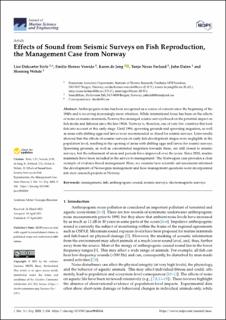| dc.contributor.author | Sivle, Lise Doksæter | |
| dc.contributor.author | de Jong, Karen | |
| dc.contributor.author | Vereide, Emilie Hernes | |
| dc.contributor.author | Forland, Tonje Nesse | |
| dc.contributor.author | Wehde, Henning | |
| dc.contributor.author | Dalen, John | |
| dc.date.accessioned | 2021-10-04T09:12:22Z | |
| dc.date.available | 2021-10-04T09:12:22Z | |
| dc.date.created | 2021-09-28T11:52:52Z | |
| dc.date.issued | 2021 | |
| dc.identifier.citation | Journal of Marine Science and Engineering. 2021, 9 . | |
| dc.identifier.issn | 2077-1312 | |
| dc.identifier.uri | https://hdl.handle.net/11250/2787407 | |
| dc.description.abstract | Anthropogenic noise has been recognized as a source of concern since the beginning of the 1940s and is receiving increasingly more attention. While international focus has been on the effects of noise on marine mammals, Norway has managed seismic surveys based on the potential impact on fish stocks and fisheries since the late 1980s. Norway is, therefore, one of very few countries that took fish into account at this early stage. Until 1996, spawning grounds and spawning migration, as well as areas with drifting eggs and larvae were recommended as closed for seismic surveys. Later results showed that the effects of seismic surveys on early fish development stages were negligible at the population level, resulting in the opening of areas with drifting eggs and larvae for seismic surveys. Spawning grounds, as well as concentrated migration towards these, are still closed to seismic surveys, but the refinement of areas and periods have improved over the years. Since 2018, marine mammals have been included in the advice to management. The Norwegian case provides a clear example of evidence-based management. Here, we examine how scientific advancements informed the development of Norwegian management and how management questions were incorporated into new research projects in Norway. | |
| dc.language.iso | eng | |
| dc.title | Effects of sound from seismic surveys on fish reproduction, the management case from Norway | |
| dc.type | Peer reviewed | |
| dc.type | Journal article | |
| dc.description.version | publishedVersion | |
| dc.source.pagenumber | 16 | |
| dc.source.volume | 9 | |
| dc.source.journal | Journal of Marine Science and Engineering | |
| dc.identifier.doi | 10.3390/jmse9040436 | |
| dc.identifier.cristin | 1939716 | |
| dc.relation.project | Norges forskningsråd: 280367 | |
| dc.relation.project | Norges forskningsråd: 302675 | |
| cristin.ispublished | true | |
| cristin.fulltext | original | |
| cristin.qualitycode | 1 | |
